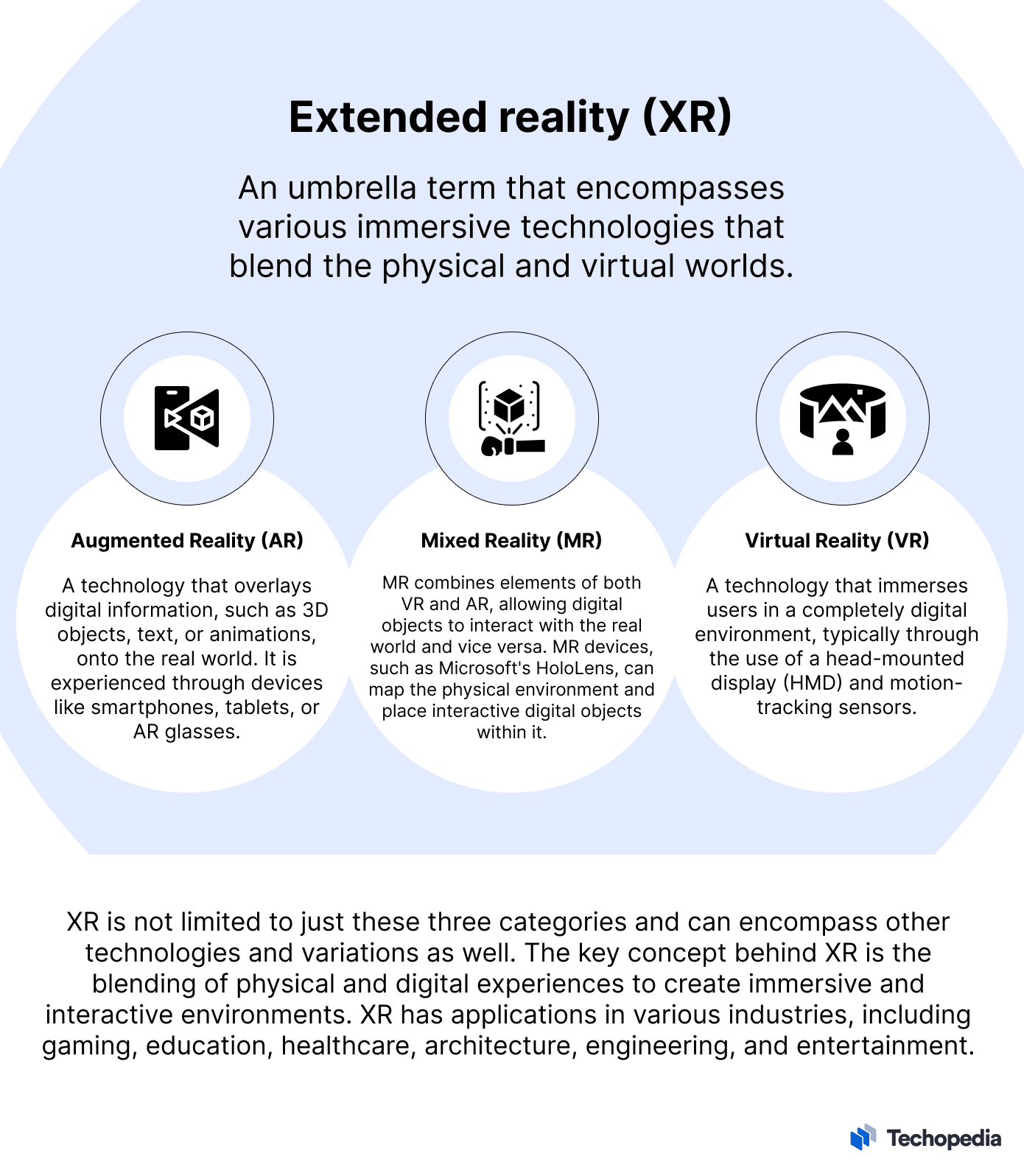What is Extended Reality (XR)?
Extended reality (XR) is defined as the spectrum of virtual and augmented experiences, which merges the physical and virtual worlds to create engaging and immersive environments where users can interact with computer-generated elements in real-time.
It leverages a combination of technologies to enhance human perceptions of reality, blurring the boundaries between the real and digital environments. XR technologies can be used for a range of experiences, from recreation to training simulations, online meetings, healthcare, and architectural design.
In its various forms, extended reality has the potential to disrupt the digital landscape, transform how we communicate and engage with information, and change the way various industries operate.
How Does Extended Reality Work?
XR is an umbrella term that encompasses virtual reality (VR), augmented reality (AR), and mixed reality (MR), which are different approaches that alter the perception of reality.
Virtual Reality
VR is the most well-known form of XR. Users wear a VR headset or goggles that have sensors to track their movements and allow them to explore computer-generated virtual environments, interact with objects, and participate in various activities displayed on screens or lenses.
Users view stereo 3D images that create the sensation of depth and immersion, while spatial audio enhances the experience through headphones or speakers. Handheld controllers track users’ motions to allow them to interact with the environment.
Augmented Reality
AR incorporates virtual content into the physical world to enhance the user’s perception and interaction with their real surroundings. AR is typically experienced with smartphones, tablets, or AR glasses, which project virtual objects, text, or images allowing users to simultaneously engage with virtual and physical elements.
The device’s camera records the user’s surroundings, and gyroscopes and accelerometers monitor the camera’s orientation and location. AR software analyzes the camera feed, which identifies objects and characteristics of the environment.
The user can interact with virtual objects using touchscreens, gestures, and voice commands.
Mixed Reality
MR is a hybrid form of XR that combines components of VR and AR. Users of MR can engage with virtual objects while staying conscious of and engaging with their physical environment. Virtual objects can interact with and respond to the real-world environment and vice versa.
Users wear specialized MR headsets or glasses, which like VR and AR hardware, use cameras, sensors, and displays to track the user’s surroundings and position to enable the display of virtual objects.
Metaverse vs. Extended Reality
The concept of the metaverse extends beyond the virtual and augmented experiences provided by XR to encompass a complete shared virtual world with its own economy, currencies, content, social interactions, and user participation.
Applications of Extended Reality
The applications of XR continue expanding as the technology develops. Here are some notable areas where XR is making an impact:
- Gaming. XR has transformed the gaming industry by providing new levels of immersive and interactive experiences.
- Education. XR is creating engaging and interactive learning experiences for students to explore historical events or conduct scientific experiments in a safe environment.
- Healthcare. XR is being used for medical training, patient rehabilitation, and even remote surgeries. Surgeons can use AR to overlay critical information during procedures, enhancing their precision.
- Architecture and design. Professionals can use MR to visualize and work with 3D models in a real-world context, improving the planning and execution of projects.
- Retail and marketing. AR is changing the way consumers shop online by allowing them to visualize products in their own spaces before making a purchase.
Advantages and Disadvantages of Extended Reality
| Pros | Cons |
| Enhanced immersion creates realistic training simulations, educational demonstrations, and entertainment. | XR hardware and software are expensive, limiting their mainstream adoption. |
| Hands-on interaction with objects, surroundings, and concepts improves learning and retention. | Some users can experience pain and sensory problems, such as motion sickness, eye strain, or confusion. |
| Collaborative working, realistic visualizations, and virtual prototyping can aid decision-making in various industries. | XR needs specialized content development and technology, requiring resources and knowledge to create high-quality content. |
| Virtual meetings and spaces support international collaboration. | Cross-platform experiences and interoperability between systems can be challenging, hindering integration and widespread adoption. |
| Sensory stimulation and flexible user interfaces can increase accessibility for users with disabilities. | XR experiences collect and analyze user data, raising concerns about data privacy and security. |
The Future of Extended Reality
Extended reality is a transformative technology that encompasses virtual reality, augmented reality, and mixed reality to blend physical and virtual environments. As the hardware, software, and user experience evolve, XR will have the potential to transform fields ranging from entertainment to education, healthcare, and industry.
However, challenges remain, including issues related to privacy, security, and accessibility. Ethical considerations surrounding XR, such as the potential for addiction and disconnection from the real world, also require attention.
Whether exploring virtual realms or enhancing the physical world with digital overlays, XR can shape the future of human interaction and innovation.






